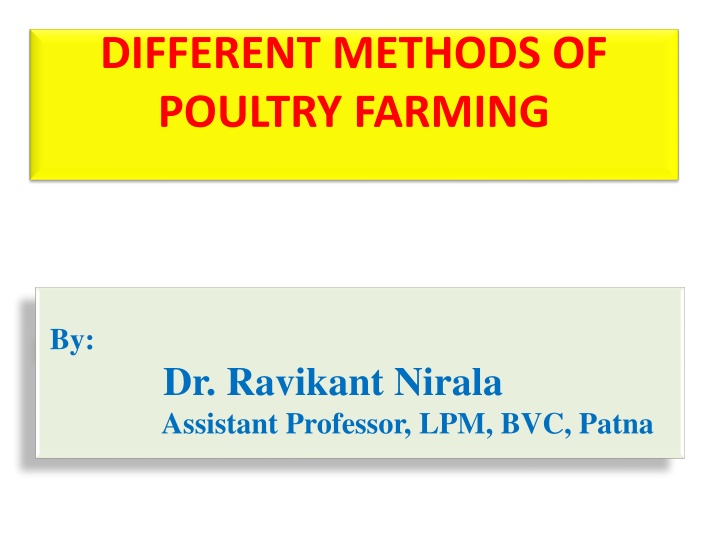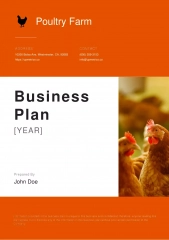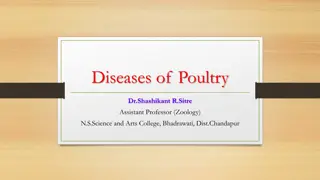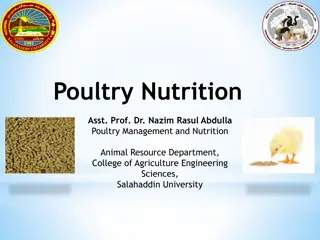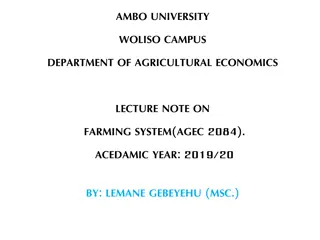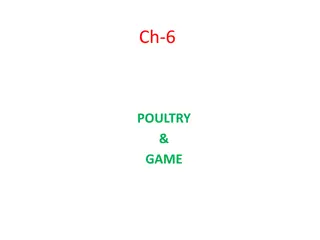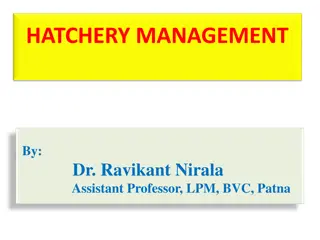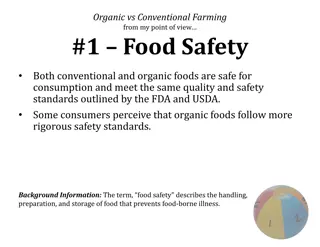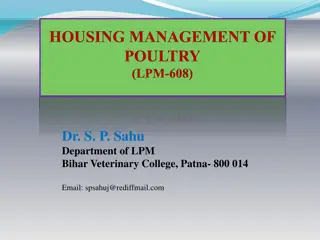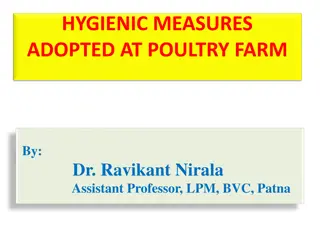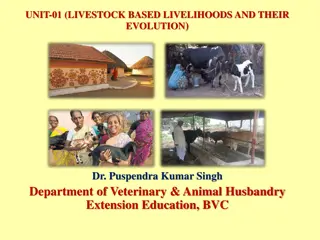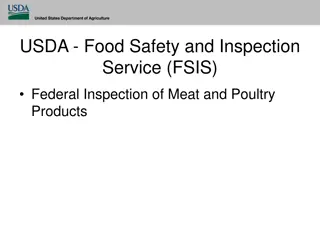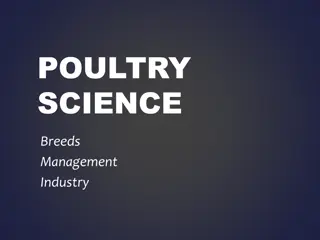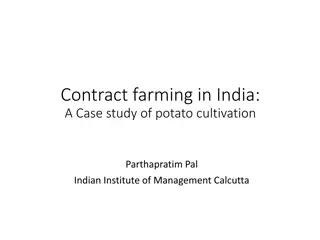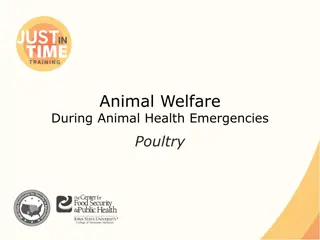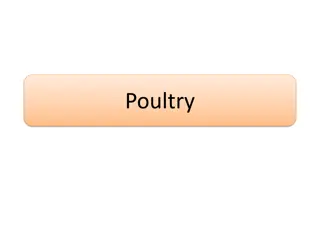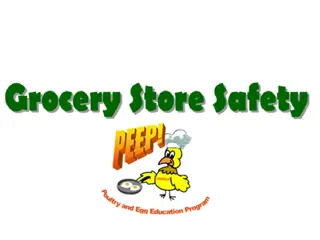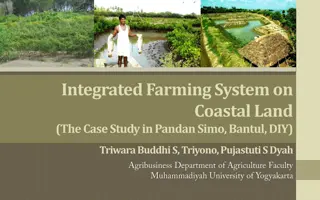Diverse Methods of Poultry Farming and Agricultural Practices
Poultry farming practices such as organic farming, nitrogen fixation, biodiversity management, and contract farming are discussed. Organic farming emphasizes holistic relationships in agriculture, promoting sustainable production. Nitrogen fixation and biodiversity management play essential roles in soil health and plant protection. Contract farming offers benefits such as risk reduction and market access. Hill farming in upland areas is primarily for rearing livestock like sheep and goats, with extensive practices in northeast India.
Download Presentation

Please find below an Image/Link to download the presentation.
The content on the website is provided AS IS for your information and personal use only. It may not be sold, licensed, or shared on other websites without obtaining consent from the author.If you encounter any issues during the download, it is possible that the publisher has removed the file from their server.
You are allowed to download the files provided on this website for personal or commercial use, subject to the condition that they are used lawfully. All files are the property of their respective owners.
The content on the website is provided AS IS for your information and personal use only. It may not be sold, licensed, or shared on other websites without obtaining consent from the author.
E N D
Presentation Transcript
DIFFERENT METHODS OF POULTRY FARMING By: Dr. Ravikant Nirala Assistant Professor, LPM, BVC, Patna
ORGANIC FARMING Organic farming endorses the concept that the soil, plants, animals and human beings are linked. In philosophical terms organic farming means farming in sprits of organic relationship . In this system everything is connected with everything else. Therefore, its goal is to create an integrated, environmentally sound, safe and economically sustainable agriculture production system. The farmer manages self-regulating ecological and biological processes for sustainable and economic production of products. Organic farming systems are based on development of biological diversity and the maintenance and Replenishment of soil productivity. The soil in this system is a living entity. It conserves soil fertility and soil erosion through implementation of appropriate conservation practices.
Meeting crop need of nitrogen through nitrogen fixation by leguminous crops in the cropping systems and recycling of farm organic materials including crop residues and livestock wastes, Importance of crop rotation, natural predators, resistance varieties and other agronomic manipulations of plant protection including weed management, and Biodiversity management, soil and environmental health. The natural ecosystems neither use any input nor demands unreasonable quantities of water. The art of organic farming is to make the best use of ecological principles and processes. The nutrients go back to the soil when leaves fall or plants die. Part of the biomass is eaten by various animals (including insects), and their excrements return the nutrients to the soil. In the soil, a huge number of soil organisms are involved in the decomposition of organic material which makes nutrients available to the plant roots again. Organic nutrient management is based on biodegradable material, i.e. plant and animal residues which can be decomposed. Nutrient cycles are closed with the help of composting, mulching, green manuring, crop rotation etc.
Processors constitute the main users of contracts, as the guaranteed supply enables them to maximize utilization of their processing capacity. Contracts with farmers can also reduce risk from disease or weather and facilitate certification, increasingly demanded by advanced markets. There are also potential benefits for national economies as contract farming leads to economies of scale, bound to provide for a more dynamic agricultural sector. become attractive to many arrangement can offer both an assured market and access to production support. Effective linkages between companies and thousands of farmers often require the involvement of formal farmer associations or cooperatives or, at least, informal farmer groups. which is being farmers because the
HILL FARMING It is an extensive farming in upland areas, primarily rearing sheep and goat, however poultry, cattle, yak and Mithun are often reared extensively in upland areas of north east India. Fell farming is the farming of fells, a fell being an area of uncultivated high ground used as common grazing. It is a term commonly used in Northern England, especially in the Lake District and the Pennine hills. Elsewhere, the terms hill farming or pastoral farming are more commonly used.
Cattle farming in the hills is usually restricted by a scarcity of winter fodder, and hill sheep, grazing at about two hectares per head, are often taken to lowland areas for fattening. Modern hill farming is often heavily dependent on state subsidy, for example in the United Kingdom it receives support from the European Union's Common Agricultural Policy. Improved, sown pasture and drained moorland can be stocked more heavily, at approximately one sheep per 0.25 hectares. Sheep farms and mixed sheep and cattle farms constitute approximately 1/4th of the agricultural land in India. These areas have a harsh climate, short growing seasons, relatively poor quality of soil and long winters. Therefore, these areas are considered to be disadvantaged and the animals raised there are generally less productive and farmers will often send them down to the lowlands to be fattened up. Upland areas are not traditionally favorable for agricultural practices. The majority of Hill farming land in England is classified as Less Favoured Area (LFA), and the LFA constitutes 17% of land farmed in England.The LFA is further divided into Severely Disadvantaged Areas (SDAs) and Disadvantaged Areas (DAs), which make up 67% and 33% of the LFA respectively. These areas are classified as such on account of poor climate, soils, and terrain which cause higher costs in production and transportation as well as lower yields and less productivity. The LFA is significant in England's farming on a whole despite
Vertical & horizontal integration in commercial poultry production The chicken industry has grown to the magnitude that it is today by combining production stages into large vertically and horizontally integrated firms able to take advantage of rapidly changing technology. Horizontal integration refers to the expansion strategy adopted by the corporations which involves acquisition of one company by another company in which both the companies are in the same business line, similar in operations and at same value chain supply level in terms of product and production to subside competition. Whereas in Vertical Integration the two firms are merged and operate at different stages of the supply chain. Horizontal Integration brings synergy, but not self-sufficiency to operate independently in the value chain, while Vertical Integration helps the company to gain synergy with self-sufficiency.
Upland areas are usually covered with both dry and wet dwarf shrub heath and, rough and either managed or unmanaged improved grasslands. During winter farmers will usually keep the animals indoors, supplementing the livestock's diet with hay or silage. The land used to grow winter feed that are not mowed are able to provide protection for including skylarks, partridge, and corncrakes who build on their nests on the ground. Agricultural use, burning, and grazing by both livestock and wild life such the upland grasslands, moorland and bogs. If these ecosystems were not maintained they would be colonized by trees and scrub. Sustainable careful maintenance is highly important in hill farming in order to protect the delicate relationship that farm manage has on the biodiversity of native plant and animal species. Upland ecosystems have seen a shift in the last century, associated with widespread habitat deterioration caused by human actions and exploitation a variety of birds as deer, helps to sustain
Horizontal Integration helps to acquire control over the market, but Vertical Integration helps in gaining control over the whole industry. Vertically integrated companies in a supply chain are united through a common owner. Usually each member of the supply chain produces a different products or services and the products combine to satisfy a common need in this case, the production of broiler chicken. There are mainly two forms of Vertical Integration namely, Forward Integration and Backward Integration. Vertical integration in the chicken industry means: Less man hours to produce more chickens, due to improved technology and larger flock sizes; A reduction in the amount of feed required to produce a kg of broiler meat, due to continual discoveries in genetics and nutrition.
A reduced growing period to produce a market broiler chicken, meaning reduced space, labour, equipment and a much smaller environmental impact; Better health programs for the welfare of birds; and Being able to go to the market at any time of the year and buy tender, flavorful chicken products at a price that is very kind to your budget. Vertical integration allows the industry to maintain strict biosecurity measures, vaccination programs and testing for bacteria such as Salmonella at breeder farms and hatcheries. Increasing entry barriers for new entrants Absorbing both upstream and downstream profits Smoothening the supply chain Fall in the quality of good due to lack of competition Companies to focus less on their core competencies and more on newly acquired businesses Reduction in flexibility to increase or decrease production levels.
Contract farming Contract poultry production being carried out on the basis of an agreement between the buyers and farm producers. Sometimes it involves the buyer specifying the quality required and the price, with the farmer agreeing to deliver at a future date. The farmer undertakes to supply agreed quantities of a crop or livestock product, based on the quality standards and delivery requirements of the purchaser. In return, the buyer, usually a company, agrees to buy the product, often at a price that is established in advance. The company often also agrees to support the farmer through, e.g., supplying inputs, preparation, providing production advice and transporting produce to its premises. farming involves agricultural and assisting with land
Export-Import In world s market India rank 5-6thin egg and 20-21stin chicken meat production. Indian export earning is very low. The present export potential from poultry product is however, a meager Rs.10-15 crores. Therefore require massive export promotion efforts. The major share of broiler export is in favour of USA, whereas 70% eggs are exported by USA, China and Holland. China has emerged as a potential exporter country from Asia along with Thailand (meat). Indian industry has to meet the norms of Hazard Analysis and Critical Control Point ( HACCP ) to produce safe products for human consumption. This because of insecticidal residue of crops, medicinal residue and the microbial contamination arising from management lapses.
The industry today ranks fifth in the world with respect to table egg production and 22ndin respect of poultry meat production. As per APEDA (Agriculture and Processed Food Products Export Development Authority) India s share in the world egg trade is estimated at 1500 tonnes worth $1.74 millions. India is presently exporting, mainly to UAE (62.5%) Oman, Maldives and Bahrain. Export of poultry meat from India commenced recently. The major destinations are Oman (30%), Maldives, and Bahrain. Live poultry export during 1992-93 was 41 lakhs and the major destinations are Bangladesh (39%) UAE and Oman. Export projection for poultry and its products (Kindly update) Products Year 2919-2020 (in Million Rupees) .. .. Poultry Egg Poultry Meat Live Poultry Value added Total Industry sources estimate that poultry export can earn heavy foreign exchange.
MIXED OR INTEGRATED POULTRY FARMING In mixed farming a farmer can take up different types of practices for income generation while doing his main business of agriculture. Mixed farming can be done together with the main agricultural practices like poultry farming, dairy farming, bee keeping, sericulture, Pisciculture, shrimp farming, goat and sheep rearing, piggery and agro forestry. Mixed farming also means operating independently, but at the same time like growing soya and rearing buffaloes. They are two independent businesses with one having little to do with the other and farmer conducts different types of agricultural practices together, on a single farm in view of increasing his income through different sources, is called as mixed farming. The greatest benefit from this type of farming is that if any one business does not pay desired benefit, the same can be recovered from the benefit of the other business. Mixed farming system consists of components such as crops and livestock that coexist independently from each other. In this farming integrating crops and livestock serves primarily to minimize the risk and not to recycle resources. two agricultural systems
On the other hand, in integrated farming, each agricultural activity is linked to the other, for inputs. One main point that makes integrated farming popular is that it is a circular cycle with the waste of one going in to the next. Thus, the by-products of one unit is utilized by others that yield its maximum output. Eg. Dairying/poultry with fish rearing in a rice and planktons growing field. Integrated Farming is a whole farm management system, which enables the farmers to identify opportunities and threats and act accordingly and at the same time, consider consumer interests in their business. The most valuable poultry production systems for fish production are those systems which produce nutrient-rich and collectable waste. Layers produce more calcium and phosphorus-rich excreta than broilers. The direct use of egg laying where the birds are of constant weight and produce fairly constant levels of waste, are easier to manage than broilers in which waste availability is cyclical
Integrated farming system is an integration of appropriate viable technologies within the enterprise and / or integration of one or more enterprises with prevailing ones at a farm according to the availability of resources and farmer s choice. It also satisfy the necessities of a household as many as possible for livelihood security of a family and simultaneously leads to better utilization of resources, increased productivity per unit area, efficient recycling of Farm wastes, generate more employment, reduce the risk and ensure environmental safety and sustainability. Much attention is being given for the development of poultry farming in India and with improved scientific management practices; poultry has now become a popular rural enterprise in different states of the country. Apart from eggs and chicken, poultry also yields manure, which has high fertilizer value. The production of poultry dropping in India is estimated to be about 1,300 thousand tons, which is about 390 metric tones of protein. Utilization of this huge resource as manure in aquaculture will definitely afford better conversion than agriculture.
The application of poultry manuring in the pond provides a nutrient base for dense bloom of phytoplankton, particularly nano planktons which helps in intense zooplankton development. The zooplankton has an additional food source in the form of bacteria which thrive on the organic fraction of the added poultry dung. Thus, indicates the need for stocking phytoplankto-phagous and zoo plankto-phagous fishes in the pond. In addition to phytoplankton and zooplankton, there is a high production of detritus at the pond bottom, which provides the substrate for colonization of micro-organisms and other benthic fauna especially the chironomid larvae. Another addition will be macro-vegetation feeder grass carp, which, in the absence of macrophytes, can be fed on green cattle fodder grown on the pond embankments. The semi digested excreta of this fish forms the food of bottom feeders. For exploitation of the above food resources, polyculture of three Indian major carps and three exotic carps is taken up in fish cum poultry ponds. The pond is stocked after the pond water gets properly detoxified. The stocking rates vary from 8000 - 8500 fingerlings/ha and a species ratio of 40 % surface feeders, 20 % of column feeders, 30 % bottom feeders and 10-20 % weedy feeders are preferred for high fish yields. Mixed culture of only Indian major carps can be taken up with a species ratio of 40 % surface, 30 % column and 30 % bottom feeders.
COMPONENTS OF AN IFS MODEL A pond of 1 acre size for fish production. Construction of Fish hatchery. A poultry house of the capacity of 1000. Duck farming of the capacity of 25 Ducks. Cows (Different stages of lactation and reproduction), calves and heifers. Gobar gas plat Vermi-compost unit of 10 beds. Floriculture Bee-keeping Agricultural component (seasonal vegetables, creepers and short fruit trees on the bund of the pond)and cereals crops on the rest of the land according to the season. One store room and staff room. Other related component which can be introduced.
